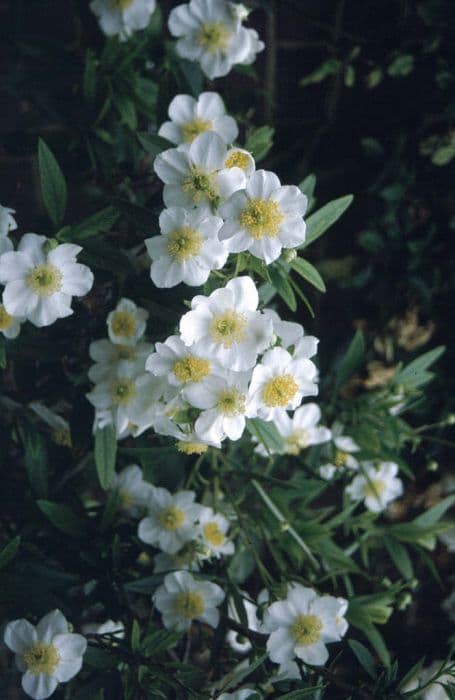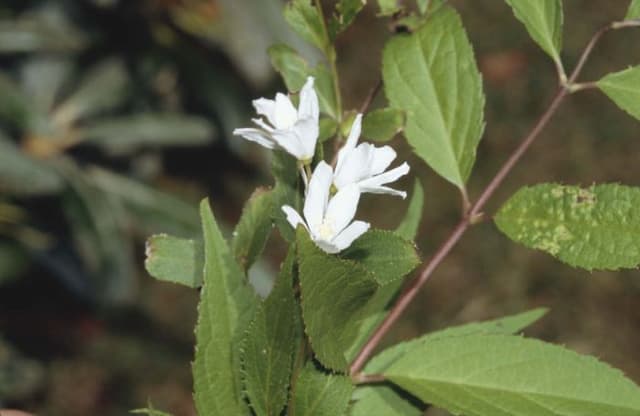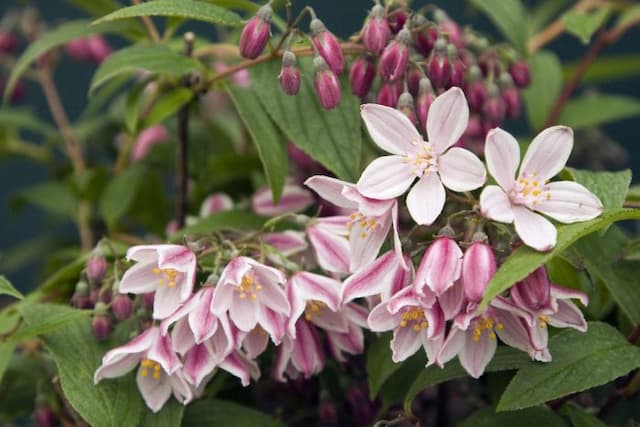Sawtoothed Hydrangea Hydrangea serratifolia

ABOUT
Hydrangea serratifolia, commonly known as the sawtooth hydrangea, is an ornamental plant with a striking presence in the garden. Its notable characteristic is the foliage, which features toothed edges, giving the plant its common name. The leaves are typically lush and deep green, providing a rich backdrop for the flowers. The flowers of the sawtooth hydrangea are its most captivating feature. They bloom in rounded clusters known as corymbs, with the individual flowers densely packed together. These blossoms are usually creamy white or sometimes tinged with a soft pink or blue hue, depending on the soil acidity. The flower heads are surrounded by small, inconspicuous bracts which add a subtle texture. As the seasons change, the foliage of the sawtooth hydrangea may turn to shades of yellow or red, adding autumnal interest to its appearance. The plant's overall form is bushy and full, making it an attractive addition to mixed borders or as a stand-alone specimen in a garden setting.
About this plant
 Names
NamesFamily
Hydrangeaceae.
Synonyms
Andes Hydrangea, Sawtoothed Hydrangea, Mountain Hydrangea.
Common names
Hydrangea peruviana, Hydrangea bridgesii.
 Toxicity
ToxicityTo humans
Hydrangea serratifolia, commonly known as the mountain hydrangea, contains cyanogenic glycosides, which can release cyanide when chewed or digested. Ingesting parts of this plant can lead to symptoms like nausea, vomiting, diarrhea, and abdominal pain. In severe cases, cyanide poisoning can result in difficulty breathing, dizziness, a rapid heart rate, seizures, and even coma or death.
To pets
The mountain hydrangea is also toxic to pets due to the same cyanogenic glycosides present in the plant. If a pet ingests this plant, it may experience symptoms such as vomiting, diarrhea, lethargy, and depression. More severe cyanide poisoning can cause difficulty breathing, increased heart rate, seizures, and potentially be life-threatening.
 Characteristics
CharacteristicsLife cycle
Perennials
Foliage type
Deciduous
Color of leaves
Green
Flower color
Cream
Height
10 feet (3 meters)
Spread
8 feet (2.4 meters)
Plant type
Shrub
Hardiness zones
9
Native area
South America
Benefits
 General Benefits
General Benefits- Aesthetic Appeal: Hydrangea serratifolia, commonly known as the Sawtooth Hydrangea, adds visual interest to gardens with its showy flower heads and attractive foliage.
- Seasonal Interest: With its flowering period extending from late spring to early autumn, Sawtooth Hydrangea provides long-lasting seasonal color and interest in landscaping.
- Pollinator Attraction: The flowers of the Sawtooth Hydrangea attract pollinators like bees and butterflies, supporting local ecosystems and biodiversity.
- Versatility in Landscaping: This plant can be used in a variety of garden settings, including borders, as a specimen plant, or in mass plantings for greater visual impact.
- Tolerance of Various Soil Types: Hydrangea serratifolia is adaptable to a range of soil conditions, though it thrives best in moist, well-drained soils.
- Shade Tolerance: This hydrangea can flourish in partial shade, making it a suitable choice for gardens with light limitations.
- Historical Interest: Due to its use in traditional gardens and associations with certain cultures, Sawtooth Hydrangea offers historical significance and can be used to create heritage-themed garden designs.
 Medical Properties
Medical Properties- Anti-inflammatory: Hydrangea serratifolia, also known as Mountain Hydrangea, may have compounds with potential anti-inflammatory properties.
- Diuretic: The plant has been used traditionally as a diuretic to help increase the flow of urine.
- Antilithic: It is thought to have antilithic effects, potentially aiding in the prevention of kidney stones.
- Antimalarial: There is some historical use of Hydrangea serratifolia as a treatment against malaria.
 Air-purifying Qualities
Air-purifying QualitiesThis plant is not specifically known for air purifying qualities.
 Other Uses
Other Uses- Hydrangea serratifolia leaves can be used as a natural dye, producing beautiful shades of blue or purple depending on the soil pH.
- The plant's woody stems are sometimes used in crafting small pieces of furniture or artistic sculptures due to their sturdy nature.
- Dried Hydrangea serratifolia flowers are incorporated into potpourris for a long-lasting and subtly pleasant fragrance.
- The blooms are popular in pressed flower art, retaining their color well and providing a delicate aesthetic to the artwork.
- Its large leaves can be used in garden mulch, as they decompose and enrich the soil with organic matter.
- Gardeners use the varying colors of Hydrangea serratifolia flowers to determine soil acidity, as a natural pH indicator.
- The bush can be grown as a living fence or privacy screen due to its dense foliage and relatively quick growth.
- In floral arrangements, the sturdy branches of Hydrangea serratifolia can provide a strong backbone to support other, more delicate flowers.
- Some cultures use the dried root wood to craft musical instruments or decorative items because of its fine grain and workability.
- The plant is sometimes included in butterfly gardens to attract pollinators, as its flowers are a nectar source for bees and butterflies.
Interesting Facts
 Feng Shui
Feng ShuiThe Hydrangea is not used in Feng Shui practice.
 Zodiac Sign Compitability
Zodiac Sign CompitabilityThe Hydrangea is not used in astrology practice.
 Plant Symbolism
Plant Symbolism- Emotion - Hydrangeas often symbolize a wide range of emotions, including anything from heartfelt, sincere emotions to frigidity and lack of empathy, as the extremities of their bloom's fullness suggest an outpouring of sentiment.
- Understanding - The diverse and complex shape of hydrangea flowers is sometimes used to symbolize understanding and patience in a relationship, due to the plant's ability to adapt to various soil types and still flourish.
- Gratitude - Some cultures gift hydrangeas as a sign of thanks or to express gratitude for being understood, as the abundant blooms can represent abundance and prosperity.
- Apology - In some contexts, hydrangeas can be given as an apology, especially in Japan where a historical emperor would send them to apologize to the family of the girl he loved.
- Vanity - The lavish appearance of the hydrangea bloom could symbolize vanity or boastfulness, hence in some interpretations, it can reflect an accusation of self-absorption.
- Fourth Anniversary - In the language of flowers, hydrangeas are often associated with the fourth wedding anniversary as symbols of appreciation and lasting gratitude.
 Water
WaterSawtooth Hydrangea should be watered thoroughly, ensuring the soil is moist but not waterlogged. Typically, watering once a week with about 1 to 1.5 gallons of water is appropriate; however, during hotter and drier periods, increase the frequency to twice a week. Ensure the water reaches the roots by watering directly at the soil level. During winter or cooler months, reduce the amount of water to prevent overwatering as the plant requires less hydration during dormancy.
 Light
LightSawtooth Hydrangea thrives best in partial to full sunlight. It should be planted in a spot that gets morning sun and afternoon shade, or in a location that receives filtered sunlight throughout the day. Avoid places that get intense, direct afternoon sun as it can lead to leaf scorch.
 Temperature
TemperatureSawtooth Hydrangea prefers moderate temperatures and can tolerate a range from about 30°F to 80°F. The ideal growth temperature for this plant is between 50°F and 75°F. Hydrangeas, in general, may not thrive well in extremely hot conditions, so during periods of high heat, it's important to ensure they have adequate shade and water.
 Pruning
PruningPruning Sawtooth Hydrangea encourages healthy growth and blooms, and is typically done in late winter or early spring before new growth starts. Remove dead or old wood and shape the plant as desired, taking care to prune right above a pair of buds. It's not necessary to prune annually, but doing so every other year can help maintain plant vigor.
 Cleaning
CleaningAs needed
 Soil
SoilSawtooth Hydrangea thrives in rich, well-draining soil with a pH between 5.5-6.5. A soil mix consisting of 1 part garden soil, 1 part peat moss, and 1 part perlite or coarse sand is ideal for promoting healthy growth and ample flowering.
 Repotting
RepottingSawtooth Hydrangea should typically be repotted every 2-3 years to refresh the soil and accommodate root growth. Spring is the best time for repotting to minimize stress on the plant.
 Humidity & Misting
Humidity & MistingSawtooth Hydrangea prefers moderate to high humidity levels, around 60-70%, for optimal growth. Maintaining these humidity levels can help ensure the plant's health and vigor.
 Suitable locations
Suitable locationsIndoor
Place Sawtooth Hydrangea in bright, indirect light and keep soil moist.
Outdoor
Ensure partial shade, shelter from winds, and keep soil moist for Sawtooth Hydrangea.
Hardiness zone
7-10 USDA
 Life cycle
Life cycleHydrangea serratifolia, commonly known as Sawtoothed Hydrangea, begins its life cycle with seed germination, usually occurring in moist, well-draining soil with partial to full shade. Following germination, the seedling phase sees the development of a small root system and initial leaves. As the plant enters the vegetative growth stage, it develops a woody stem, larger leaves, and extensive roots, preparing for the reproductive phase. During the flowering stage, typically in early spring to late summer, Sawtoothed Hydrangea produces clusters of small, fertile, and larger, sterile flowers that attract pollinators. After pollination, the plant produces small capsule-like fruits that contain numerous seeds, ready for dispersal. Finally, in the senescence phase, the plant experiences reduced growth and may die back, especially in colder climates, although it can re-sprout from the roots the following season.
 Propogation
PropogationPropogation time
Spring to Summer
Propogation: The most popular method of propagation for Hydrangea serratifolia, commonly known as the Andean Hydrangea, is through softwood cuttings. This technique is typically performed in late spring or early summer when the new growth is still tender and green. Cuttings should be about 4 to 6 inches (about 10 to 15 centimeters) long with several leaves, and the lower end should be cut just below a leaf node. The bottom pair of leaves are removed and the cut end is dipped in rooting hormone to encourage root development. The treated cutting is then planted in a moist potting mix, and high humidity is maintained around the cutting by covering it with a plastic bag or placing it in a propagation case. Roots usually develop within a few weeks, after which the new plants can be gradually acclimatized to less humid conditions before being planted out.







![Hydrangea [Strong Annabelle]](/_next/image?url=https%3A%2F%2Fplants-admin.emdemapps.com%2Fimages%2Fplants%2F%2Fimages%2F604b54db37d34.png&w=640&q=75)

